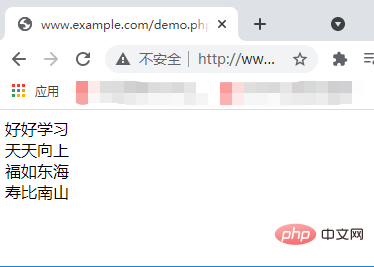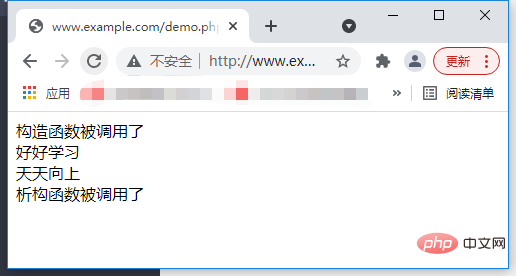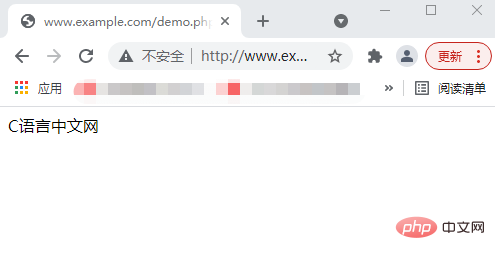Let you distinguish the constructor and destructor in a class
In the previous article, I brought you "How to instantiate objects and access object members in PHP? ", which introduces in detail how to instantiate objects and access object members. In this article, we will take a look at the constructors and destructors in PHP. I hope it will be helpful to everyone!

The constructor in a PHP class is also called a constructor. When an object is instantiated using the new keyword, it can be automatically called when the object is created. It is the a special function. The corresponding function is the destructor. The role of the destructor is exactly the opposite of the constructor. The destructor can perform operations before the object is destroyed. Then let's take a look at these two functions together.
<strong><span style="font-size: 20px;">__construct()</span></strong>:Constructor/method
In PHP classes, we use __construct() as the constructor of the class. The constructor is the first function that is automatically called in the class when the object is created, and can only exist in a class. A constructor, and it should be noted that if there are parameters in the constructor, then the corresponding parameters also need to be passed in for instantiation.
The syntax format created by the constructor is as follows:
public function __construct(参数列表){
... ...
}It should be noted that the parameter list is optional and can be omitted when not needed. construct is preceded by two underscores __.
The examples are as follows:
<?php
class study{
public $study1, $study2, $study3,$study4;
public function __construct($str1, $str2, $str3,$str4){
$this -> study1 = $str1;
$this -> study2 = $str2;
$this -> study3 = $str3;
$this -> study4 = $str4;
$this -> demo();
}
public function demo(){
echo $this -> study1.'<br>';
echo $this -> study2.'<br>';
echo $this -> study3.'<br>';
echo $this -> study4.'<br>';
}
}
$object = new study('好好学习','天天向上','福如东海','寿比南山');
?>$this in the example represents the currently called object. Output result:

From the above results, we pass the __construct() constructor to call the object created in the class.
<strong><span style="max-width:90%">__destruct()</span></strong>: Destructor/Method
Just mentioned__construct()The constructor function will be called when the object is created. The corresponding function is the destructor. The destructor function is opposite to the constructor function. The destructor function It will only be automatically called when the object is deleted from the memory. There is a garbage collection mechanism in PHP. When the object cannot be accessed, the garbage collection mechanism will be automatically started. The destructor is called before the garbage collection object.
__destruct()The syntax format of the function is as follows:
public function __destruct(){
... ...
}It should be noted that, similar to the constructor, destruct is also preceded by two underscores __;The difference is that the destructor cannot take any parameters.
The example is as follows:
<?php
class Website{
public $study1, $study2;
public function __construct(){
echo '构造函数被调用了<br>';
}
public function __destruct(){
echo '析构函数被调用了<br>';
}
}
$object = new Website();
echo '好好学习<br>';
echo '天天向上<br>';
?>Output result:

It can be seen from the above example that the constructor and The destructor is called at different times. The constructor is automatically called when the object is created, and the destructor is called before the object is collected by the garbage collector.
<strong><span style="max-width:90%">$this</span></strong>:The current object
is in PHP In object programming, after the object is created, in each member method of the object, there will be a special object reference "$this", which is connected with the connector -> Used jointly, specifically to complete access between internal members of an object. An example is as follows:
$this -> 成员属性; $this -> 成员方法(参数列表);
When we access a member attribute in a class, we only need to follow the attribute name. There is no need to add the $ sign. $this can only be used in objects. Without an object, there is no $this.
The example is as follows:
<?php
class Website{
public $name;
public function __construct($name){
$this -> name = $name;
$this -> name();
}
public function name(){
echo $this -> name;
}
}
$object = new Website('好好学习');
?>Output result:

If you are interested, you can click "PHP Video tutorial》Learn more about PHP knowledge.
The above is the detailed content of Let you distinguish the constructor and destructor in a class. For more information, please follow other related articles on the PHP Chinese website!

Hot AI Tools

Undresser.AI Undress
AI-powered app for creating realistic nude photos

AI Clothes Remover
Online AI tool for removing clothes from photos.

Undress AI Tool
Undress images for free

Clothoff.io
AI clothes remover

Video Face Swap
Swap faces in any video effortlessly with our completely free AI face swap tool!

Hot Article

Hot Tools

Notepad++7.3.1
Easy-to-use and free code editor

SublimeText3 Chinese version
Chinese version, very easy to use

Zend Studio 13.0.1
Powerful PHP integrated development environment

Dreamweaver CS6
Visual web development tools

SublimeText3 Mac version
God-level code editing software (SublimeText3)

Hot Topics
 PHP 8.4 Installation and Upgrade guide for Ubuntu and Debian
Dec 24, 2024 pm 04:42 PM
PHP 8.4 Installation and Upgrade guide for Ubuntu and Debian
Dec 24, 2024 pm 04:42 PM
PHP 8.4 brings several new features, security improvements, and performance improvements with healthy amounts of feature deprecations and removals. This guide explains how to install PHP 8.4 or upgrade to PHP 8.4 on Ubuntu, Debian, or their derivati
 7 PHP Functions I Regret I Didn't Know Before
Nov 13, 2024 am 09:42 AM
7 PHP Functions I Regret I Didn't Know Before
Nov 13, 2024 am 09:42 AM
If you are an experienced PHP developer, you might have the feeling that you’ve been there and done that already.You have developed a significant number of applications, debugged millions of lines of code, and tweaked a bunch of scripts to achieve op
 How To Set Up Visual Studio Code (VS Code) for PHP Development
Dec 20, 2024 am 11:31 AM
How To Set Up Visual Studio Code (VS Code) for PHP Development
Dec 20, 2024 am 11:31 AM
Visual Studio Code, also known as VS Code, is a free source code editor — or integrated development environment (IDE) — available for all major operating systems. With a large collection of extensions for many programming languages, VS Code can be c
 Explain JSON Web Tokens (JWT) and their use case in PHP APIs.
Apr 05, 2025 am 12:04 AM
Explain JSON Web Tokens (JWT) and their use case in PHP APIs.
Apr 05, 2025 am 12:04 AM
JWT is an open standard based on JSON, used to securely transmit information between parties, mainly for identity authentication and information exchange. 1. JWT consists of three parts: Header, Payload and Signature. 2. The working principle of JWT includes three steps: generating JWT, verifying JWT and parsing Payload. 3. When using JWT for authentication in PHP, JWT can be generated and verified, and user role and permission information can be included in advanced usage. 4. Common errors include signature verification failure, token expiration, and payload oversized. Debugging skills include using debugging tools and logging. 5. Performance optimization and best practices include using appropriate signature algorithms, setting validity periods reasonably,
 PHP Program to Count Vowels in a String
Feb 07, 2025 pm 12:12 PM
PHP Program to Count Vowels in a String
Feb 07, 2025 pm 12:12 PM
A string is a sequence of characters, including letters, numbers, and symbols. This tutorial will learn how to calculate the number of vowels in a given string in PHP using different methods. The vowels in English are a, e, i, o, u, and they can be uppercase or lowercase. What is a vowel? Vowels are alphabetic characters that represent a specific pronunciation. There are five vowels in English, including uppercase and lowercase: a, e, i, o, u Example 1 Input: String = "Tutorialspoint" Output: 6 explain The vowels in the string "Tutorialspoint" are u, o, i, a, o, i. There are 6 yuan in total
 How do you parse and process HTML/XML in PHP?
Feb 07, 2025 am 11:57 AM
How do you parse and process HTML/XML in PHP?
Feb 07, 2025 am 11:57 AM
This tutorial demonstrates how to efficiently process XML documents using PHP. XML (eXtensible Markup Language) is a versatile text-based markup language designed for both human readability and machine parsing. It's commonly used for data storage an
 Explain late static binding in PHP (static::).
Apr 03, 2025 am 12:04 AM
Explain late static binding in PHP (static::).
Apr 03, 2025 am 12:04 AM
Static binding (static::) implements late static binding (LSB) in PHP, allowing calling classes to be referenced in static contexts rather than defining classes. 1) The parsing process is performed at runtime, 2) Look up the call class in the inheritance relationship, 3) It may bring performance overhead.
 What are PHP magic methods (__construct, __destruct, __call, __get, __set, etc.) and provide use cases?
Apr 03, 2025 am 12:03 AM
What are PHP magic methods (__construct, __destruct, __call, __get, __set, etc.) and provide use cases?
Apr 03, 2025 am 12:03 AM
What are the magic methods of PHP? PHP's magic methods include: 1.\_\_construct, used to initialize objects; 2.\_\_destruct, used to clean up resources; 3.\_\_call, handle non-existent method calls; 4.\_\_get, implement dynamic attribute access; 5.\_\_set, implement dynamic attribute settings. These methods are automatically called in certain situations, improving code flexibility and efficiency.






